What Cops Look For
What Cops Look For to Detect Impaired Drivers
Police departments throughout Maryland use guidelines set by the National Highway Traffic Safety Administration (NHTSA) to "detect" drivers who exhibit certain effects or symptoms of impairment. Listed below are the visual clue descriptions police use in making this determination. Next to each clue, is a probability (out of 100) that a driver exhibiting that clue is impaired. For example, the 65 for the first clue, Turning With Wide Radius, means that chances are 65 out of 100 that a driver who makes a wide turn is impaired. Each value shown is based on seeing only one clue. If two or more clues are seen, add 10 to the highest value among the cues observed.
Under the NHTSA guidelines, you need to drive practically in the center of the lane at all times, and never deviate from the exact center, or you will exhibit at least one "clue" of impairment!
65% Turning With Wide Radius
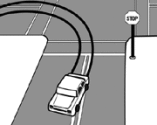
During a turn, the radius defined by the distance between the turning vehicle and the center of the turn is greater than normal.
65% Straddling Center of Lane Marker
The vehicle is moving straight ahead with the center or lane marker between the left-hand and right-hand wheels
60% Appearing to be Drunk
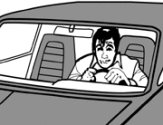
This clue is actually one or more of a set of indicators related to the personal behavior or appearance of the driver.
Examples of "appearing to be drunk" include:
- Eye Fixation
- Tightly gripping steering wheel
- Slouching in the seat
- Gesturing erratically or obscenely
- Face close to the windshield
- Drinking in the vehicle
- Driver's head protruding from vehicle
60% Almost Striking Object or Vehicle
The observed vehicle almost strikes a stationary object or another moving vehicle. Examples include: passing abnormally close to a sign, wall, building, or other object; passing abnormally close to another moving vehicle; and causing another vehicle to maneuver to avoid collision.
60% Weaving
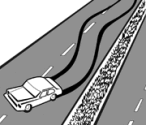
Weaving occurs when the vehicle alternately moves toward one side of the roadway and then the other, creating zig-zag course. The pattern of lateral movement is relatively regular as on steering correction is closely followed by another.
55% Driving on Other Than Designated Roadway
The vehicle is observed being driven on other than the roadway designated for traffic movement. Examples include driving: at the edge of the roadway, on the shoulder, off the roadway entirely, and straight through turn-only lanes or areas.
55% Swerving
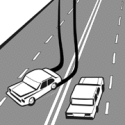
A swerve is an abrupt turn away from a generally straight course. Swerving might occur directly after a period of drifting when the driver discovers the approach of traffic in an oncoming lane or discovers that the vehicle is going off the road; swerving might also occur as an abrupt turn is executed to return the vehicle to the traffic lane. In the illustration, a swerve was executed to return to a lane after a period of drifting toward opposite traffic.
50% Speed Slower than 10 MPH Below Limit
The observed vehicle is being driven at a speed that is more than 10 MPH below the speed limit.
50% Stopping Without Cause in Traffic Lane
The critical element in this cue is that there is no observable justification for the vehicle to stop in the traffic lane; the stop is not caused by traffic conditions, traffic signals, an emergency situation, or related circumstances. Intoxicated drivers might stop in lane where their capability to interpret information and make decisions becomes severely impaired. As a consequence, stopping (without cause) in the traffic lane is likely to occur at intersections or other decision points.
50% Following Too Closely
The vehicle is observed following another vehicle while not maintaining the legal minimum separation.
50% Drifting
Drifting is a straight-line movement of the vehicle at a slight angle to the roadway. As the driver approaches a marker or boundary (lane marker, center line, edge of the roadway), the direction of the drift might change. As shown in the illustration, the vehicle drifts across the lane marker into another lane, then the driver makes a correction and the vehicle drifts back across the lane marker. Drifting might be observed within a single lane, across lanes, across the center line, onto the shoulder, and from lane to lane.
45% Tires on Center or Lane Marker
The left-hand set of tires of the observed vehicle is consistently on the center line, or either set of tires is consistently on the lane marker.
45% Driving Into Opposing or Crossing Traffic
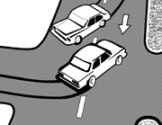
The vehicle is observed heading into opposing or crossing traffic under one or more of the following circumstances: driving in the opposing lane; backing into traffic; failing to yield the right-of-way; driving the wrong way on a one-way street. The last circumstances is illustrated.
40% Slow Response to Traffic Signals
The observed vehicle exhibits a longer than normal response to a change in traffic signal. For example, the driver remains stopped at the intersection for an abnormally long period of time after the traffic signal has turned green.
40% Signaling Inconsistent With Driving Actions
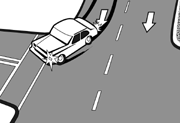
A number of possibilities exist for the driver's signaling to be inconsistent with the associated driving actions. This cue occurs when inconsistencies such as the following are observed: failing to signal a turn or lane change; signaling opposite to the turn or lane change executed; signaling consistently with no accompanying driving action; and driving with four-way hazard flashers on.
35% Stopping Inappropriately (Other Than in Traffic Lane)
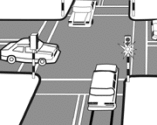
The observed vehicle stops at an inappropriate location under the conditions, other than in the traffic lane. Examples include stopping: in a prohibited zone; at a crosswalk; far short of an intersection; on a walkway; across lanes; for a green traffic signal; or for a flashing yellow traffic signal.
35% Turning Abruptly or Illegally
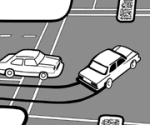
The driver executes any turn that is abnormally abrupt or illegal. Specific examples include: turning with excessive speed; turning sharply from the wrong lane; making a U-turn illegally; turning from outside a designated lane.
30% Accelerating or Decelerating Rapidly
This cue encompasses any acceleration or deceleration that is significantly more rapid than that required by the traffic conditions. Rapid acceleration might be accompanied by breaking traction; rapid deceleration might be accompanied by an abrupt stop. Also a vehicle might alternately accelerate and decelerate rapidly.
30% Headlights Off
The observed vehicle is being driven with both headlights off during a period of the day when the use of headlights is required.
Complete the FREE DUI Case Evaluation Form and Scott will contact you to discuss your case. While some law firms substitute attorneys (imagine walking into court to see someone that you have never met there to represent you!) when you hire Scott Athen to represent you in court, you get Scott Athen!









